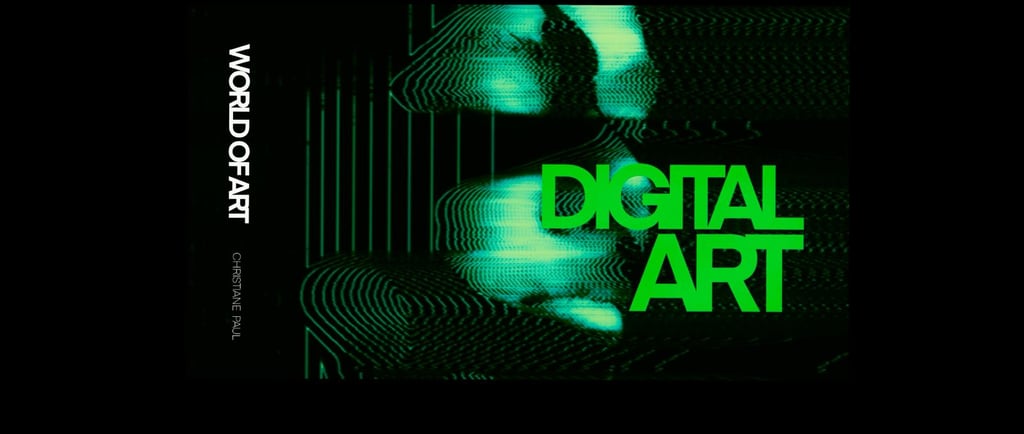"Digital art isn’t just a new medium . It’s a new cosmology." Christiane Paul
When art becomes data, experience, and real-time interaction, collecting shifts from acquisition to stewardship. Inspired by Christiane Paul, I reflect on the new responsibilities of those who choose to preserve digital art: visionaries who protect not just works, but their very conditions of existence.
BOOK ON MY TABLE
Charlotte Madeleine CASTELLI
6/20/20253 min read


When I first opened Digital Art by Christiane Paul, I wasn’t simply reading a book , I was searching for a key, a direction, a compass to navigate the shifting and still partly unmapped landscape of digital art: this text represented a threshold for me:, a moment of both critical awareness and renewed vision.
As a curator immersed daily in experimentation with artists, technologists, and researchers, I found in its pages not only a theoretical framework, but a deep resonance with the challenges we face in real-world curatorial practice.
“Digital art is not just a new medium, but a new cosmology.” (C. Paul)
And I couldn’t agree more. Digital art doesn’t merely introduce new expressive tools; it redefines the coordinates by which we think about art itself — about time, matter, presence. In this new cosmology, the visible coexists with the invisible, the tangible dissolves into experience, and interaction and participation become foundational elements. The artwork is no longer static — it is a living event, a relational space, an open system that involves the creator, the viewer, and the custodian. This is precisely where one of the central challenges of digital collecting unfolds — a challenge we face every day at Future Maastricht with rigorous attention and a strong sense of responsibility. The collector is no longer a silent patron or a resourceful observer; they become an active participant in a complex ecosystem composed of infrastructures, code, licenses, servers, updates, and smart contracts. Paul articulates it with striking clarity:
“To collect digital art is to collect a network, an ecosystem.” And it’s true: collecting digital art today means taking responsibility for the continuity of a work that may be unstable, relational, even intentionally ephemeral. The contemporary collector acts as a distributed curator — or as I like to call it, a poetic archivist: a custodian not of the object, but of the very conditions that enable its future existence. One question I often pose during our interdisciplinary working sessions with artists, engineers, conservators, and legal experts is: what exactly are we collecting? The file? The hash? The interface? The interactive experience? The semantic network? The answer, of course, is complex and plural. And it’s precisely this complexity that demands new collecting models — ones that integrate versioning, maintenance, process documentation, traceability, planned obsolescence, and adaptability to future technological environments.
At Future Maastricht, we work closely with pioneering collectors — individuals, institutions, and foundations who have embraced this challenge as part of their cultural commitment. Take, for example, decentralized collections based on smart contracts, where acquisition is not limited to symbolic ownership but opens up dynamics of activation, governance, and co-curation. In these cases, collecting becomes a form of project-making, a conscious responsibility that cannot exist without transparency, collaboration, and a systemic vision.
On the institutional level, many well-established entities — from ZKM to Rhizome, from the DSL Collection to the Thoma Foundation — have already acknowledged the need for new strategies in the preservation and display of digital art. But it is often the younger institutions, like ours, that have the freedom to truly experiment. We’ve learned that it’s not enough to digitize traditional curatorial practices — we must curate the digital in its own language. We must develop new taxonomies, new protocols to ensure readability, accessibility, and longevity — as well as an aesthetic, ethical, and poetic dimension.
One particularly crucial theme that Digital Art addresses with precision is that of sustainability:
“Sustainability in digital art is not an afterthought but an imperative.”
Digital art has a real-world impact — it consumes resources, generates computational loads, and relies on devices and technologies that rapidly become obsolete. As a curator, I feel it is my duty to interrogate these costs — material, energetic, and human — and to promote more sustainable alternatives. We can no longer speak of innovation without also integrating ecological responsibility into our curatorial and collecting decisions.
What ultimately emerges from this path is a new hybrid figure: the collector-curator. Someone capable of reading the weak signals of the future, of bringing aesthetics and technology into dialogue, of weaving together art and infrastructure, vision and maintenance. In a world where everything is potentially replicable and volatile, collecting becomes a profound act of responsibility — a gesture of care.
Digital Art was not simply an illuminating book for me, but a starting point and a horizon,:every collection is also a form of writing time. And that today, more than ever, our role as institutions is not just to exhibit the future but to learn how to collect it.
© Charlotte Madeleine Castelli | All rights reserved
